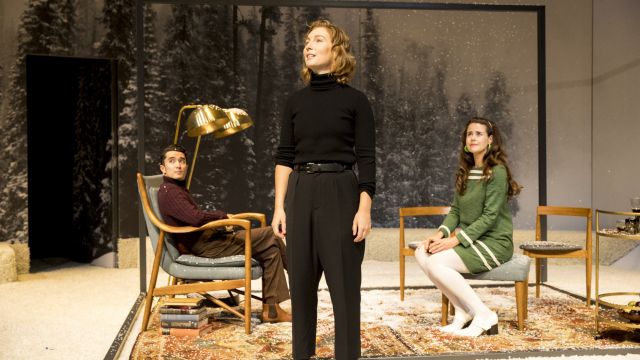Hamlet
Returning to the Playhouse after two COVID-jammed, performance-free years comes this tight production of Shakespeare’s most famous play. A packed, masked audience showed its standing approval of a three-hour performance featuring ghosts, multiple murders and betrayals, not to mention some of the greatest lines, scenes and soliloquies ever written.
On a marvellous indoor/outdoor setting by Anna Tregloan featuring tall wintry trees, the famous drama unfolds under the taut direction of Peter Evans. A dead king patrols the royal grounds of 1960’s Denmark: not so much a palace as a country nook. Shakespeare’s mighty scenes are rendered using a sixties armchair, two chairs and a tiny drinks cabinet, over which snow falls virtually throughout.

To this unroyal setting comes the production’s ace: Harriet Gordon-Anderson plays Hamlet with brio and unbridled energy. The fact that she’s a woman is obvious and strangely beside the point. You stop for a moment, wondering if the company has noticed she’s female, but very soon the character takes over and only Shakespeare rules the roost. ‘Frailty thy name is woman’, the Prince of Denmark says quite early in the first half. This description passes quite unnoticed.
Throughout, Gordon-Anderson plays Hamlet at full tilt, planning and scheming, changing his mind, dressed in deepest black, dragging the body of poor old Polonius hither and yon, beating all comers on the fencing court. It’s a commanding performance.

Queen Gertrude is played by Lucy Bell as a feather-brained fool, unable to see the mess her mooning with the King’s brother has landed her in. King Claudius is fine, rising above a slow start in Act One to achieve status and import in the closing stages: maybe the slow start had something to do with his armchair/throne.
Rose Riley is a lively Ophelia, throwing out hints, and there’s a splendid Polonius from Robert Menzies, whose retainer’s doddering is wearily accepted by all on stage. Director Evans gives him a great death scene when his hiding place ‘behind the arras’ is here reversed: we can see him and not, as usual, the Queen.

The play grips anew as the end nears and all and sundry slip towards complete ruination. Ah, Shakespeare!
Frank Hatherley
Photographer: Brett Boardman
Subscribe to our E-Newsletter, buy our latest print edition or find a Performing Arts book at Book Nook.

